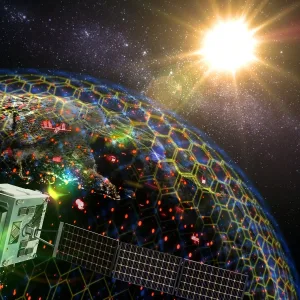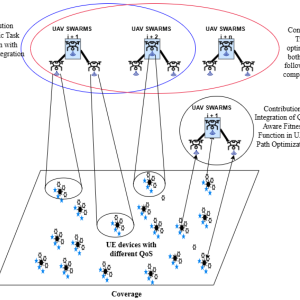Link 16 phaseout is no longer a taboo subject. As the Space Development Agency (SDA) fields the Proliferated Warfighter Space Architecture (PWSA), leaders now frame laser communications as the practical bridge from PowerPoint to CJADC2 in the real world. Launches continue in tranches on a two‑year rhythm. Optical crosslinks and ground entry points are scaling, which turns low Earth orbit (LEO) into a resilient, high‑throughput backbone for kill webs.
“As space becomes increasingly contested and congested … laser comms offer higher throughput, lower latency and inherent resistance to interception,” noted the Mitchell Institute’s Jennifer Reeves during AFA’s Air, Space & Cyber conference.
Key Facts
- What’s new: SDA says optical terminals and ground entry points are scaling; tranche launches continue on a two‑year cadence [2][3].
- Why it matters: Laser crosslinks and space‑to‑ground optics can act as the data backbone of CJADC2, moving sensor‑to‑shooter data over a proliferated LEO mesh [2].
- Reality check: Link 16 remains critical. SDA is enabling a global Link 16 network via space relays through Tranche 1–2 [2].
- Constraints: Weather, precision pointing and terminal interoperability are still technical challenges; GAO noted on‑orbit maturity gaps in 2025 [3].
From Link 16 to light: what is actually shifting
Link 16 solved a 1990s problem: common tactical data links across allied platforms, using jam‑resistant waveforms and time division multiple access. It is ubiquitous and coalition‑proven, yet spectrum‑bound. SDA’s optical comms strategy attacks those limits by moving heavy data to laser links that deliver three practical advantages.
- Throughput and latency: Multi‑Gbps crosslinks and microsecond‑class switching let sensor‑rich concepts of operation run at theater scale.
- LPI/LPD benefits: Narrow beams and no RF emissions shrink interception surfaces in electronic‑warfare dense fights.
- Routing flexibility: With proliferated LEO and optical ground entry points, data can route around jamming and re‑enter where needed.
The aim is not to turn radios off. The aim is to right‑size RF—including Link 16—for control, cueing and last‑meter delivery, while optics carry bulk data like fused tracks and imagery at machine speed.
Near‑term reality: no immediate sunset
SDA officials are clear: there is no immediate sunset for Link 16. Tranche 1 and Tranche 2 explicitly include space‑enabled Link 16 connectivity to connect terrestrial networks “to any point on Earth.” That preserves continuity of operations while laser comms scale and terminals spread. In practice, RF and optics will co‑exist for years. The curve bends as optical density grows and costs fall [2].
What the transition looks like on the edge
- Hybrid kill webs: ISR payloads push bulk data via optical crosslinks; shooters receive distilled tracks over Link 16 or other RF. During massed fires or swarms, optics prevent RF choke.
- Global backhaul: Optical ground entry points link to passing satellites, turning proliferated LEO into an any‑to‑any backbone across theaters.
- Edge learning: As data‑movement costs fall, every node can learn from every other, improving target recognition and dynamic retasking.
What could slow the phaseout
Laser comms have homework. Atmospheric turbulence, cloud cover and fine pointing between moving satellites and ground terminals can degrade links. Terminal interoperability and optical standards remain uneven. A recent GAO review found SDA had not fully demonstrated key on‑orbit laser‑link tech. SDA and industry have since executed multi‑vendor demonstrations, yet scaling across fleets still takes time [3][4][5].
Doctrine will also evolve. Commanders need confidence in optical availability across weather regimes, plus procedures for RF fallbacks and store‑and‑forward behavior. Finally, coalition adoption matters—Link 16’s ubiquity speeds joint operations but slows change.
Industrial‑base and procurement implications
- Terminal economics: As production ramps, unit costs for optical terminals should fall. Expect spiral upgrades that add optics alongside RF suites rather than immediate swaps.
- Network services: A market for optical ground stations and managed backhaul is emerging, blending government and commercial capacity with service‑level agreements keyed to weather diversity and multi‑orbit routing.
- Standards & security: Key management over optical, cross‑domain solutions for releasability and interoperable pointing/acquisition/tracking (PAT) profiles remain hard problems.
Outlook: timelines and decision gates
- 2025–2027 (Tranche 1–2): Field global Link 16 relay via PWSA; expand on‑orbit optical demos; add tactical optical sites. Link 16 stays primary for many tactical users [2][3].
- 2028–2031 (Tranche 3–4): Optics become the default transport for bulk data where weather and terminal density allow. Selective Link 16 off‑ramps begin.
- Beyond 2032: Formal sunset planning for use‑cases covered by optical + next‑gen RF. Coalition pathways set the pace.
Strategic bottom line
The Link 16 phaseout will be incremental and conditions‑based. SDA’s optical mesh is not a wholesale replacement. It is a re‑platforming of data movement: RF for tactical immediacy and coalition reach; optics for heavy lift. Winners will invest early in dual‑path terminals, weather‑diverse ground entry and software‑defined routing that treats space as a programmable fabric.
Internal link
See our analysis of AMASS: adaptive swarms C2 for multi‑domain warfare [1].
External context
For program milestones and oversight, see recent reporting and audits via DefenseScoop and the U.S. GAO [2][3]. For inter‑vendor laser‑link demos, see DefenseScoop and Breaking Defense [4][5].
Further Reading
- Adaptive swarms and command autonomy across CJADC2 [1]
- GAO’s 2025 assessment of SDA laser links and maturity [3]
- Multi‑vendor optical crosslink demonstrations and implications [4][5]
References
- Defence Agenda — AMASS: adaptive swarms C2 for multi‑domain warfare
- DefenseScoop — Pentagon contemplating eventual sunsetting of Link 16 amid enthusiasm for optical communications
- U.S. Government Accountability Office — Space Development Agency: Laser Communications — Progress and Remaining Risks (GAO‑25‑106838)
- DefenseScoop — SDA demos laser link between two vendors
- Breaking Defense — SDA eyes inter‑vendor laser links in LEO
Tags: Link 16 phaseout, SDA, optical communications, CJADC2, PWSA, laser crosslinks, tactical datalinks, GAO report, DefenseScoop, Breaking Defense











